With
the formation of a cataract, activities like reading,
sports, or driving can be difficult. Fortunately, vision
usually can be restored quickly, allowing the patient
to return home and back to normal activity within a
short time after surgery. With new advances in cataract
surgery, noticeable visual improvement usually begins
almost immediately, and an eye patch is rarely needed.
What
is a Cataract?
A
cataract is the clouding of the lens of the natural
eye. Normally, light passes through the clear lens and
is focused onto the retina (place
mouse cursor over the "eye" diagram).
However, as a result of the natural aging process, the
lens gradually becomes cloudy (place
mouse cursor over the "mountain meadow" diagram).
The cataract, or cloudy lens, blocks the passage of
light through the eye and causes distorted or blurred
vision.
Restoring
Vision
Once
a cataract has formed, the most effective way to restore
vision is to remove the cloudy cataract and replace
it with a plastic lens implant (Intraocular lens or
IOL -- provides excellent vision and requires no special
care after cataract surgery).
With
recent advances in cataract surgery equipment and techniques,
vision can be restored safer and faster, allowing patients
to resume normal activities within hours after surgery
(some activities may be limited during healing). Using
these state-of-the-art techniques, cataract surgery
has a success rate of greater than 98%.
No
- stitch, Self Sealing Incision Surgery
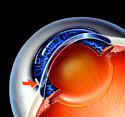 |
A
small 1/8 inch opening (instead of a relatively
wide incision) is created with a specific self sealing
technique. The new technique places the incision
into the cornea (clear part of the eye that covers
the iris or colored portion of the eye) just next
to the sclera (white part of the eye). |
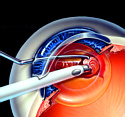 |
Ultrasound
is used to gently break up (or emulsify) the cloudy
lens into tiny pieces which can be removed through
the tip of the "phaco" probe instead of a wide incision.
|
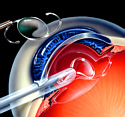 |
A
special lens (IOL) is then implanted through the
smaller incision. |
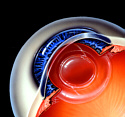 |
The
final replacement lens is shown in place. The small
"No Stitch" incision does not require sutures. |
Key
Benefits of "No-Stitch" phacoemulsification.
- No
placement or removal of sutures.
- May
be performed under local Anesthesia .
- Reduces
postoperative restrictions.
- Improves
postoperative vision and minimizes postoperative astigmatism.
What
to Expect After Surgery
Many
patients are pleased to find that after phacoemulsification,
cataract surgery, their vision improvement begins almost
immediately, and they return home shortly after the
procedure. Patients may find their vision better than
ever; however, many will need to wear glasses for reading
and other activities following the procedure. During
the initial healing period, there may be a few limitations
on strenuous activities. However, most people find that
they are able to return to a normal lifestyle immediately,
in addition to doing things poor cataract vision had
restricted them from doing in the past.
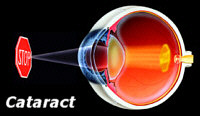
(place
mouse cursor over the "eye" diagram)
"Secondary"
Cataracts
During
cataract surgery, a clear capsule surrounding the cataract
is left in place to support the lens implant. In some
cases, this capsule may turn cloudy months or years
after surgery, creating a "secondary" cataract. If this
occurs, an outpatient laser procedure will quickly restore
good vision.
Sight
Loss Can Be Prevented
Permanent
loss of sight from cataracts is usually preventable.
With modern technology, cataracts can be removed and
good vision restored when a person feels the loss of
vision is great enough to interfere with daily activities.
If you are experiencing the symptoms of cataracts or
other vision problems, you should obtain a complete
eye examination.
|

